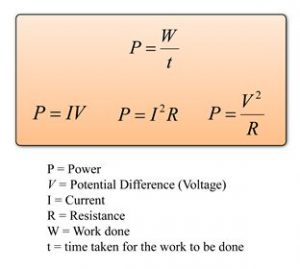Power
- The electric power, P is defined as the rates of energy that supply to the circuit ( or the rates of work been done ) by sources of electric.
- The unit of electric power is the watt (W).
- One watt of power equals the work done in one second by one volt of potential difference in moving one coulomb of charge.
- The electrical power of an electric circuit component can be found from the following equations:
Where
P = power
t = time
I = current
V = potential difference
R = resistance

Example 1:
A current of 0.50A flows through a 100Ω resistor. What is the power lost in the resistor?
Example 2
An electric iron has a heating element of resistance 50Ω. If the operating current flowing through it is 4A, calculate the heat energy produced in 2 minutes.
Example 3
What is the power dissipated in a 4Ω light bulb connected to a 12V battery? What is the power dissipated in a 2Ω light bulb connected to the same battery? Which bulb is brighter?
Answer:
Assume that the bulbs are resistor
Power dissipated in the 4Ω resistor,
Power dissipated in the 2Ω resistor,
The power of the 2Ω bulb is higher, hence it is brighter.
[Conclusion: The lower the load resistance in a circuit, the greater the power dissipated in the circuit]
Example 4
An ideal battery with e.m.f. 12 V is connected in series to two bulbs with resistances R1 = 4Ω and R2 = 2Ω What is the current in the circuit and the power dissipation in each bulb?
Answer:
Potential difference across the 2 resistors, V = 12V
Equivalence resistance of the 2 resistors, R = 4 + 2 = 6Ω
Current in the circuit,
Power dissipated in R1
Power dissipated in R2
[Conclusion: In a series connection, the greater the resistance of a resistor, the greater the power dissipated]
Example 5
The figure above shows that an ideal battery is connected in parallel to two resistors with resistances 2Ω and 4Ω. Find the power dissipated in
a. the 4Ω resistor
b. the 2Ω resistor
Answer:
a. The potential difference across the 2 resistors = 12V
The power of the 2Ω resistor,
b.
The power of the 4Ω resistor,
[Conclusion: In a parallel connection, the lower the resistance, the greater the power of the resistor.]




I saw this blog and I have benefited a lot. From this site I hope you can stomach the price of good quality and dighasthayi batteries. With the Cd/md and All 12v Electronics , Digital Camera, Wireless Camera / Baby Monitor, Portable 12v UPS Battery is also available in all types of batteries.
For more information about their services, feel free to visit their site http://www.amazon.com/dp/B00DY1YMTW/.